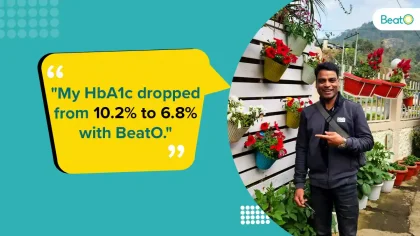According to a 2023 study, approximately 11.4% of individuals in India are diabetic, a figure that has increased from the past year and continues to escalate. This figure shows the instances where patients got tested and diabetes was detected. However, there are cases where people get to know about this disease very late in their life which leads to many serious issues such as damage to eyes, kidneys, heart, etc. Hence, it is important to take effective diagnostic tests to detect and manage diabetes early on in life.

Among all the blood glucose monitoring tests available, the Oral Glucose Tolerance Test, or OGTT test stands out as an effective measure to detect diabetes. This test plays an important role in assessing the ability of an individual to respond to consumed glucose from food, and particularly, it helps identify Type-2 and gestational diabetes.
Also Read: TSH Normal Ranges In Men And Women Explained
What is the Oral Glucose Tolerance OGTT Test
Oral Glucose Tolerance is the ability of the body to handle the consumption of glucose (sugar that breaks down from food you eat). An oral glucose tolerance test measures how well your body processes sugar in your bloodstream. By monitoring this, the OGTT test provides valuable information about glucose metabolism. It helps identify various forms of diabetes, including gestational diabetes (which happens during pregnancy) and impaired glucose tolerance.
Therefore, it becomes important to know more about this test, its process, advantages, types, and risks associated with the same. Here in this article, we will provide deep intricacies about this vital test for healthcare providers and individuals.
Also Read: 7 Best Home Remedies To Ease Diabetes Leg Pain
Why is OGTT Test Done?
This test is done to determine the ability of the body to handle sugar after a meal. Your body breaks down the food into sugar whenever you eat. This sugar enters into your blood which is used for energy. The OGTT test involves a comparison of glucose levels in the blood before and after drinking a sugar solution which ultimately helps to determine the presence of diabetes in the body. Altough, this test is not required if you already have diabetes.
Preparations for the Oral Glucose Tolerance Test
To prepare for this test and its reliable results, one must be in perfect health conditions, i.e. with no illnesses as OGTT test is not accurate for sick people.
There are a few special requirements that a person must follow before the test:
- A person has to fast for around 8-10 hours before this test to get accurate results.
- One must not smoke or consume caffeine on the morning of the test.
- Eat and drink normally a few days before the test.
- Don’t take any medicines without your doctor’s prescription.
- Make sure your stress and anxiety levels are in control before the test
Also Read: Unlocking the Potential: Is Beaten Rice Good for Diabetes?
Process of the OGTT for Type 2 diabetes and Gestational Diabetes
You can take the OGTT test at any nearby healthcare facility, or in a clinic, hospital, or lab. The test includes a few steps. Initially, a healthcare provider takes a sample of blood from a vein in your arm. This blood sample is used to measure your fasting blood sugar level.
For Type 2 Diabetes and Prediabetes:
Now, if you are being tested for either type 2 diabetes or prediabetes
- You have to drink a glucose solution containing 75 gm of sugar
- After 1 or 2 hours, your blood sample will be taken and the blood sugar level will be measured
For Gestational Diabetes:
The Diabetes found in pregnant women is known as gestational diabetes. The testing is usually done between 24 and 28 weeks of pregnancy and you do not need to fast before this test. This is also known as a one-hour test.
- In this case, firstly, a sample of your blood is taken, and the blood sugar level is measured.
- Then you will be given a glucose solution to drink containing 50 grams of sugar.
- One hour later, another blood sample is taken, and the blood sugar level is checked.
If the blood sugar level is high even by a certain amount, your healthcare will suggest another test for which you have to fast for 8 hours first. This is also known as a three-hour test.
- Your blood sample will be taken and your blood sugar level will be measured.
- Then you will be given a glucose solution to drink containing 100 gm of sugar.
- After 2 or 3 hours, your blood sugar level will be tested again.
Also Read: How Does Plant Based Diet Help Diabetes?
Results of OGTT Test
The results of both tests will be given in mg/dl or mmol/dl and the readings of the test will differ for normal, diabetic, and gestational diabetic persons.
Type 2 Diabetes Results:
- A normal blood glucose level is below 140 mg/dL (7.8 mmol/L).
- A blood glucose level between 140 and 199 mg/dL (7.8 and 11 mmol/L) is considered prediabetes. If you have prediabetes or impaired glucose tolerance, you’re at risk of developing type 2 diabetes. You’re also at risk of heart disease.
- A blood glucose level of 200 mg/dL (11.1 mmol/L) or higher suggests diabetes and you must start taking the treatments and precautions soon.
Gestational Diabetes Results:
For the initial test, a blood sugar level of 190 milligrams per deciliter (mg/dL), or 10.6 millimoles per liter (mmol/L), or higher indicates gestational diabetes. A blood sugar level below 140 mg/dL (7.8 mmol/L) usually is considered within the standard range for the test.
If you have tested for the three-hour test:
- A healthy fasting blood sugar level is 95 mg/dL (5.3 mmol/L) or lower.
- One hour after you drink the glucose solution, a normal blood sugar level is 180 mg/dL (10 mmol/L) or lower.
- Two hours after you drink the glucose solution, a normal blood sugar level is 155 mg/dL (8.6 mmol/L) or lower.
- Three hours after you drink the glucose solution, a normal blood sugar level is 140 mg/dL (7.8 mmol/L) or lower.
If two or more are higher than normal, you will be likely to have gestational diabetes.
Also Read: 7 Home Remedies For Diabetic Foot Pain
Types of the Oral Glucose Tolerance OGTT Test
There are 2 types of glucose tolerance tests; a glucose challenge test which is a short version, or the preliminary test, and a full glucose tolerance test.
Glucose Challenge Test: It is the short version of the glucose tolerance test. The test can be done at any time of the day. It involves drinking a glass of concentrated glucose (sugar) solution made from 50 grams (g) of glucose dissolved in 250 to 300 milliliters (ml) of water. After one hour has passed, a blood sample is taken to determine the blood sugar level.
Full Glucose Test: You should not eat anything before going to the doctor in the morning for OGTT test. In other words, you should not have breakfast, and you should eat your last meal the evening before. Also, don’t drink anything other than water.
Firstly, a blood sample is taken to determine your baseline blood sugar level. The blood is drawn from a vein or your fingertip or earlobe. After that, you drink a large glass of sugar solution. In the glucose tolerance test, 75g of glucose is dissolved in 250 to 300 ml of water. If the test is being done to confirm suspected diabetes, blood is drawn again after two hours and the blood sugar level is measured.
When testing for gestational diabetes in pregnant women, blood is drawn one hour after drinking the solution (containing 100 gm of sugar) and then again after another two hours.
Also Read: How Does Plant Based Diet Help Diabetes?
Risks and Side Effects of Oral Glucose Tolerance Test
The oral Glucose Tolerance Test is generally a reliable test with no major risks associated. However, people with higher levels of diabetes or the occurrence of gestational diabetes in an earlier pregnancy are at some sort of side effects due to the glucose solution or from the needle stick such as nausea, constipation, or, stomach discomfort.
Conclusion
In conclusion, the Oral Glucose Tolerance Test (OGTT) is an effective and easily accessible way to determine diabetes in your body in the initial stage only. By monitoring blood sugar levels with the help of a glucose solution at specific intervals, doctors can easily evaluate an individual’s glucose tolerance and the presence of diabetes in the body. Although the OGTT test demands patients to follow certain rules by its’ time and fasting characteristics, as it informs the technicians about many aspects of your metabolic health.
Disclaimer: The content of this article is compiled information from generic and public sources. It is in no way a substitute, suggestion, or advice for a qualified medical opinion. Always consult a specialist or your own doctor for more information. Beato App does not claim responsibility for this information.
Are you looking for the perfect glucometer to check your blood sugar level? Try out BeatO smartglucometerkit, affordable and easy to use.
Discover top-tier diabetes care with BeatO’s Chief Clinical Officer,Dr. Navneet Agarwal. His expertise in Diabetes ensures personalised guidance for overall health. Try out a smartglucometerand keep track of blood sugar levels now.




